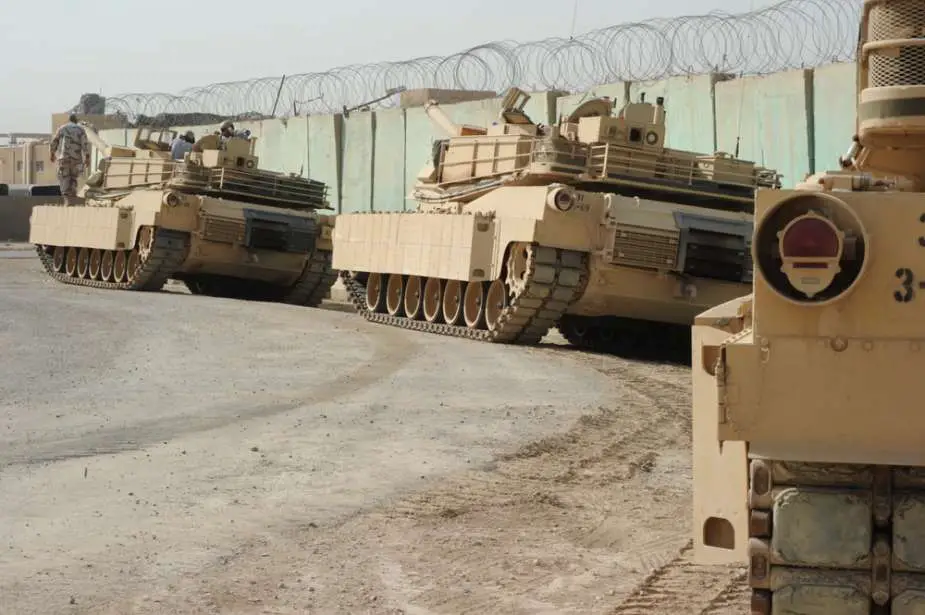On September 25, 2023, as reported by The New York Times, a pair of US officials, speaking under the condition of anonymity due to the absence of formal announcements, confirmed the delivery and the presence of an undisclosed quantity of M1A1 Abrams Main Battle Tanks in Ukraine. This revelation follows an earlier Army Recognition report from August 8, 2023, which outlined the initial delivery of Abrams tanks during the early autumn season. The tanks in question are of the older ex-U.S. Marine Corps M1A1 variants, chosen for their quicker availability compared to the more modern A2 iteration.
Follow Army Recognition on Google News at this link

M1A1 Abrams Main Battle tanks during a training course in 2010 (Picture source: US DoD)
It is probable that these tanks were accompanied by various provisions, including ammunition, spare components, and fuel-related equipment. Based on the August report, it is reasonable to infer that the initial shipment likely comprised between 6 to 8 tanks, with the overarching plan involving the delivery of a total of 31 tanks, equivalent to a Ukrainian battalion's strength. However, before Ukrainian forces can effectively utilize these tanks, they must undergo a 10-week training program, utilizing 31 trainer tanks stationed at Germany's Grafenwoehr base.
The decision made by the US government to provide these tanks is in line with its commitment to bolster Ukraine's defensive capabilities and extend support for its ongoing counteroffensive operations. Presently, Ukrainian forces are confronting well-fortified Russian positions that span a substantial frontline. The introduction of Abrams tanks is expected to furnish additional firepower to assist in navigating these fortified positions. The Abrams tanks will join a roster of other Western-manufactured tanks already supplied to Ukraine, including the Stridsvagn 122, Leopard 2A4 and 2A6, and Challenger 2.
Despite the optimism surrounding the early arrival of the tanks in Ukraine, uncertainties persist due to the refurbishment process, which includes the removal of sensitive technologies, such as classified depleted uranium armor, from the older vehicles.
Collaborative efforts between the U.S. and its European allies are currently underway to establish comprehensive maintenance and repair facilities. These facilities play a pivotal role in sustaining the Abrams tanks and other heavy armored vehicles designated for Ukraine. This cooperative initiative aims to provide training to Ukrainian personnel, ensuring proficient repairs and a consistent supply of spare parts, thereby contributing to the enduring enhancement of Ukraine's military capabilities.
The impending arrival of the Abrams tanks is anticipated to confer an advantage on Ukraine's military operations, particularly in the disputed southern and eastern regions. In these areas, Ukrainian forces are diligently identifying vulnerabilities in the Russian defensive lines. Despite the challenge posed by heavily fortified Russian positions along the extensive frontline, Ukrainian forces remain resolute in their determination to regain control of territory and persist in their counteroffensive endeavors.
The M1A1 Abrams Main Battle Tank represents a significant evolution from the earlier M1 Abrams Main Battle Tank (MBT). Its production occurred from August 1985 to early 1993, and General Dynamics Land Systems oversaw its delivery. This version incorporates several improvements, including updates to its suspension system, enhanced armor protection, and a redesigned turret gun mount. It has since become the standard main battle tank for the U.S. armed forces, with over 4,796 units manufactured for the U.S. Army and an additional 221 for the U.S. Marines. Additionally, other nations, including Egypt, Australia, Iraq, Poland, and now Ukraine, have also integrated this capable armored vehicle into their tank fleets.
From a technical standpoint, the M1A1 Abrams boasts formidable firepower, featuring the 120mm M256 smoothbore gun as its primary armament. This cannon can effectively utilize various types of ammunition, including depleted uranium armor-piercing rounds. The tank is also equipped with auxiliary weaponry, including a 7.62mm coaxial machine gun and a 12.7mm anti-aircraft machine gun. Its armor protection is substantial, incorporating Chobham composite armor with integrated depleted uranium plates, offering exceptional defense against both kinetic energy and chemical energy threats.
Notably, the tank's mobility is a key feature. Powered by a Honeywell AGT 1500 gas turbine engine, the M1A1 can achieve speeds of up to 68 km/h, facilitating high mobility across diverse terrains. It adeptly handles steep gradients, water obstacles, and trenches. Furthermore, the tank is outfitted with advanced accessories, including a fire control system, laser range finder, night vision equipment, thermal sight, NBC (Nuclear, Biological, and Chemical) protection, and an automatic fire extinguishing system.
















